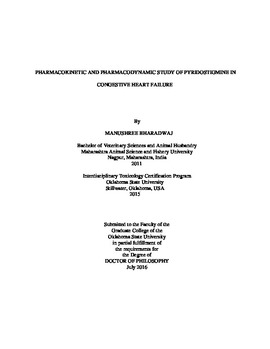| dc.contributor.advisor | Maxwell, Lara | |
| dc.contributor.author | Bharadwaj, Manushree | |
| dc.date.accessioned | 2017-02-22T22:08:31Z | |
| dc.date.available | 2017-02-22T22:08:31Z | |
| dc.date.issued | 2016-07 | |
| dc.identifier.uri | https://hdl.handle.net/11244/48782 | |
| dc.description.abstract | Sympathetic overactivity and parasympathetic withdrawal indicate profound dysregulation of autonomic control in patients with congestive heart failure. Pyridostigmine binds to the acetylcholinesterase enzyme and inhibits its action on acetylcholine. Thus, pyridostigmine may contribute to restoring the balance between the sympathetic and parasympathetic arms of the autonomic system in the heart. We hypothesized that pyridostigmine increases parasympathetic tone and thus improves autonomic balance in the heart. In the first aim, a rodent model of heart rate recovery (HRR) was developed to test the hypothesis that subacute pyridostigmine administration enhances HRR in rats. Rapid heart rate deceleration after exercise or HRR is associated with the activation of parasympathetic tone. Male Sprague-Dawley rats treated with pyridostigmine (0.14 mg/ml/day in the drinking water) showed a significant decrease in acetylcholinesterase activity in plasma and red blood cells (RBCs) (P<0.001), whereas plasma butyrylcholinesterase activity did not significantly change (P=0.99). HRR recorded 1 min after the end of exercise was higher in the pyridostigmine-treated group as compared with the control group (P=0.002). The parasympathetic tone was higher in the pyridostigmine-treated rats as compared with control (P<0.001) indicating that pyridostigmine enhanced parasympathetic tone and associated HRR in rats. Under the second aim, analytical methods were developed to quantify pyridostigmine and its metabolite 3-hydroxy-N-methylpyridinium in human plasma using sensitive hydrophilic interaction liquid chromatography-electrospray ionization-tandem mass spectrometry assays. Accuracy and precision values for each assay were within the acceptable limits described in FDA guidelines. In the final aim of the study, a population-based pharmacokinetic model was used to compare two types of structural base models after oral pyridostigmine administration for ten weeks. The two-compartment model was determined to best fit the pyridostigmine plasma data and parameter estimates for pyridostigmine were reported. In conclusion, subacute pyridostigmine administration to rats enhanced HRR by increasing cardiac parasympathetic tone, making this rodent model an appropriate tool for further testing of the effects of pyridostigmine of autonomic tone. A sensitive method was developed to quantify pyridostigmine and its metabolite 3-hyroxy-N-methylpyridinium in human plasma. Lastly, a population-based pharmacokinetic model estimated the variability in the pharmacokinetic parameters of pyridostigmine in heart failure patient population. | |
| dc.format | application/pdf | |
| dc.language | en_US | |
| dc.rights | Copyright is held by the author who has granted the Oklahoma State University Library the non-exclusive right to share this material in its institutional repository. Contact Digital Library Services at lib-dls@okstate.edu or 405-744-9161 for the permission policy on the use, reproduction or distribution of this material. | |
| dc.title | Pharmacokinetic and pharmacodynamic study of pyridostigmine in congestive heart failure | |
| dc.contributor.committeeMember | Pope, Carey | |
| dc.contributor.committeeMember | Wagner, Jarrad | |
| dc.contributor.committeeMember | Payton, Mark | |
| osu.filename | Bharadwaj_okstate_0664D_14770.pdf | |
| osu.accesstype | Open Access | |
| dc.type.genre | Dissertation | |
| dc.type.material | Text | |
| thesis.degree.discipline | Veterinary Biomedical Sciences | |
| thesis.degree.grantor | Oklahoma State University | |
